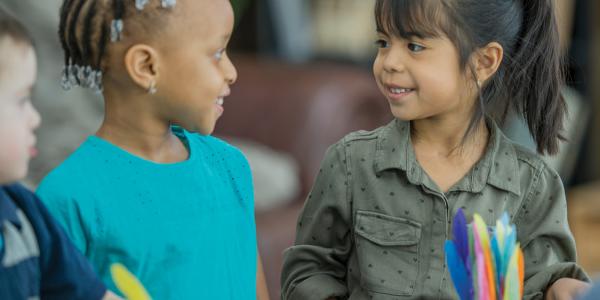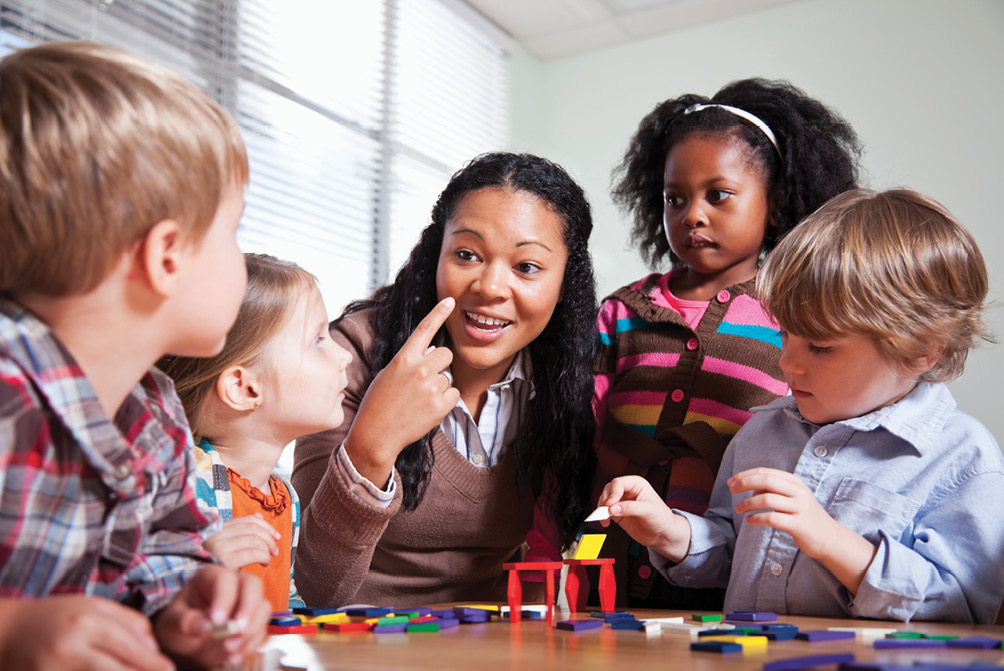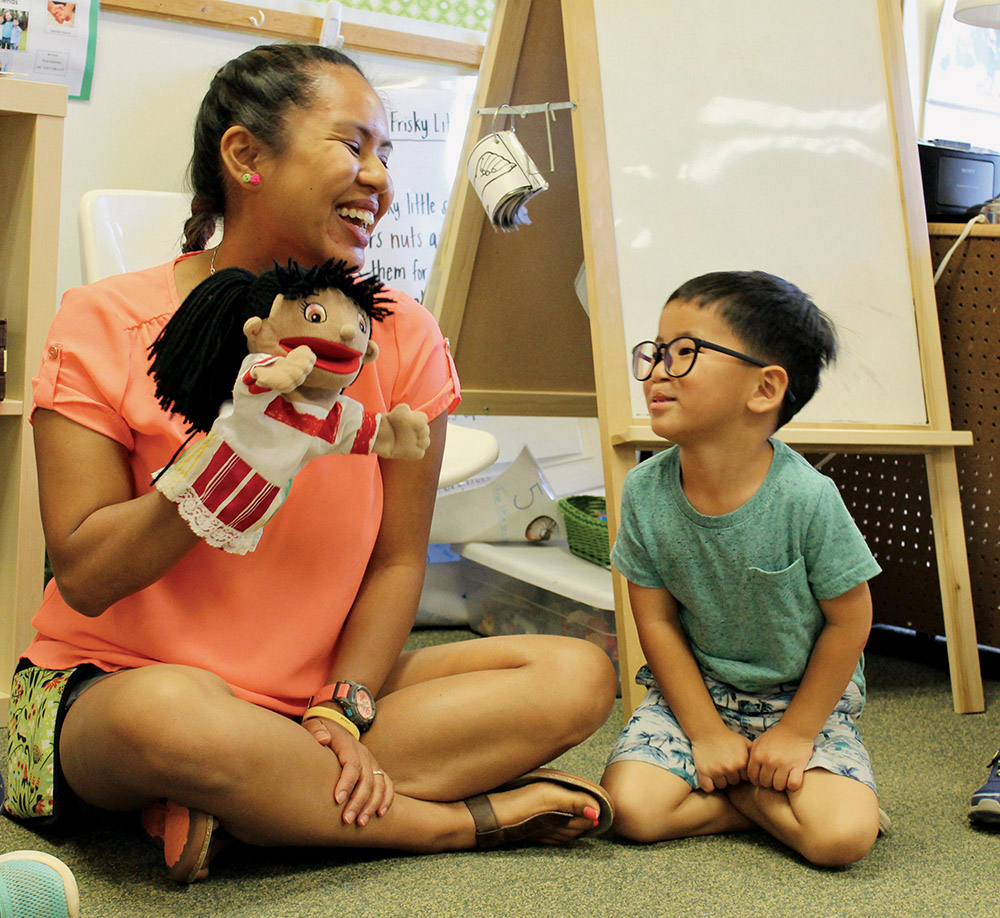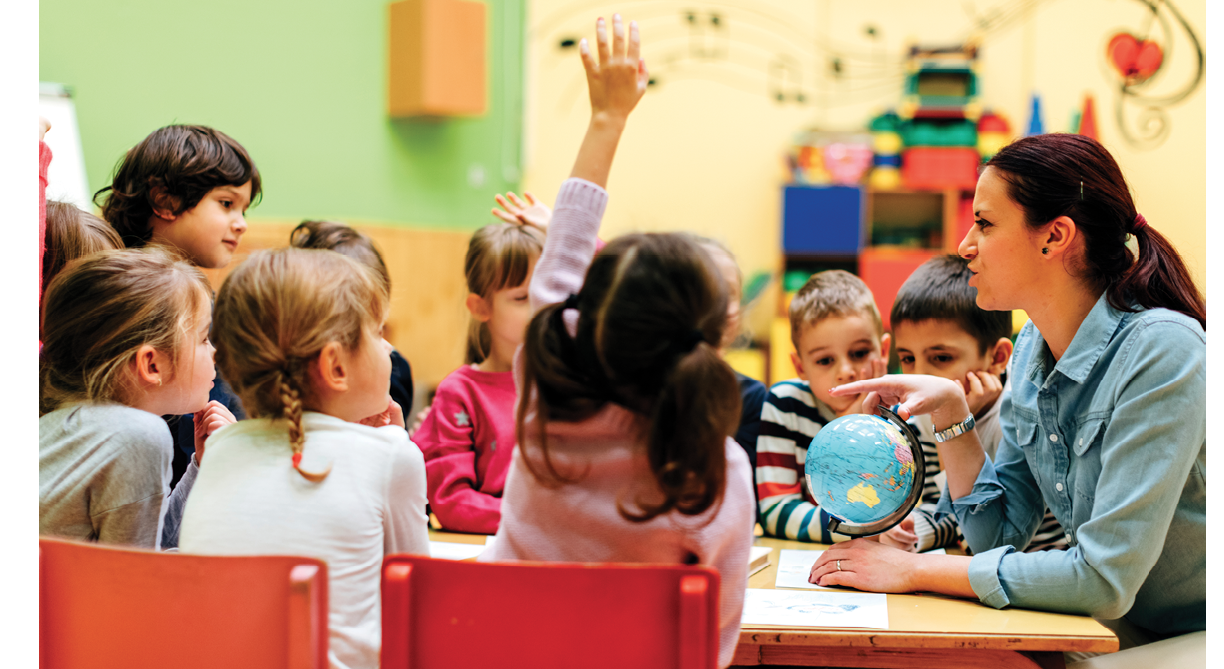Becoming Upended: Teaching and Learning about Race and Racism with Young Children and Their Families

You are here
At the beginning of the year in Ms. Verwayne’s kindergarten class, the children are working on an All About Me project. They begin by drawing pictures of themselves based on observations of their reflections in a mirror. Next, the teacher provides them with sentence starters asking them to describe their hair color and texture, their skin color, and their eye color. In this racially and ethnically diverse class, the children learn a variety of vocabulary words they can use to describe these differences.
On the playground after school, some of the parents chat about the project. One White mom, Ellie, tells the other parents that the project made her feel a little uncomfortable. She explains, “Since this is the beginning of the year, shouldn’t the kids be doing things that help them see what they have in common, rather than emphasizing their differences?”
Many parents and teachers of young children share Ellie’s concern that children should be shielded from learning explicitly about race and racial differences. Adults often worry that introducing these topics too early could be harmful (Husband 2010). Early childhood educators who wish to make space for learning about race and racism in their classrooms may feel unprepared to approach these complex issues (Vittrup 2016). Shaped by their own experiences with issues of race and racism, parents and teachers may hold differing views regarding the appropriateness of teaching about this topic in the early childhood classroom.
Research demonstrates that children’s awareness of racial differences and the impact of racism begins quite early (Tatum 2003; Winkler 2009). Multiple studies document the ways that young children take notice of racial differences and note that as early as preschool, children may begin excluding their peers of different races from play and other activities (Winkler 2009). Many argue that creating safe spaces for children to explore these topics is more important than ever, given the current political and cultural climate, where these issues are highly visible (Pitts 2016; Harvey 2017; Poon 2017). As such, parents and teachers have an obligation to teach and learn with children about these critical and complex issues (Delpit 2012; Derman-Sparks, LeeKeenan, & Nimmo 2015; Ramsey 2015). This article documents how one kindergarten teacher, Diandra Verwayne (the second author), worked with the parents in her classroom to grow together in their understandings of the role we all must play in talking with young children about race and racism. Additionally, this piece offers curricular and pedagogical resources for adults who are committed to engaging with young children in this crucial work.
Learning about race and unlearning racism
In her seminal research and writing on this topic, Beverly Daniel Tatum (a former psychology professor and president of Spelman College) has written extensively about the ways in which the unjust structure of racial hierarchy in American society is normalized and transmitted to children from birth (Tatum 2003). In discussing how messages about race-based privilege and oppression are internalized, Tatum provides a powerful metaphor. She explains that in the same way residents who live in highly polluted areas cannot avoid becoming “smog breathers,” Americans who are immersed in the structures and practices of white supremacy unwittingly become “racism breathers” (6). Many of us may not realize the degree to which these toxic beliefs shape our perceptions and experiences of the world. Unless we have opportunities to unlearn racism, these messages become absorbed and have consequences.
Schools, in collaboration with families, have an important role to play in fostering young children’s positive racial identities.
More recently scholars have documented the negative impact that being subjected to racism has on young children’s academic success, as Lisa Delpit (2012) conveys in her aptly titled book chapter, “There Is No Achievement Gap at Birth.” These consequences vary depending on our levels of privilege and oppression, which intersect across our diverse identities. Early childhood educators can support the unlearning of racism—and minimize later breathing in of racism—by intentionally teaching about race and related issues. Schools, in collaboration with families, have an important role to play in fostering young children’s positive racial identities. Teachers who intentionally plan curricula that affirm children’s racial identities have seen the benefits this produces in supporting children’s growth and learning across many domains of development (Ladson-Billings 2009; Wright, Counsell, & Tate 2015).
There is often confusion about the difference between racially based bias and racism. Racism is a system of oppression that results from a combination of prejudice and power. This combination produces institutional structures and social practices that deny equity to people based on race. There is a common misconception that biases or prejudices that some people of color hold against White people constitutes “reverse racism.” Anyone can hold a bias against people of another race, but only some races are subject to oppressive structures and practices as a result of that bias. To illustrate, consider a comparison to sexism. Some women are biased against men, but this is not “reverse sexism”; only men’s biases against women have produced the conditions in which women are subjected to far more sexual harassment and sexual violence than men (Breiding et al. 2014). Similarly, racism has created structures and practices that deny equity and justice to people of color, including, for example, great disparities by race in family wealth. One of the most reliable ways to accumulate and pass on family wealth is through home ownership. Until recently, many Black Americans—including those with high incomes—were unable to buy houses because of redlining, a practice by which banks refused to offer mortgages in predominately Black neighborhoods. This is a key factor explaining why median wealth for White families in the US is about $134,000, while the median wealth for Black families is about $11,000 (Jones 2017). This disparity in family wealth accumulated over several generations and will likely take several more generations to address; meanwhile, it continues to have broad implications for access to opportunity, such as parents’ ability to pay their children’s college tuition.
For all children to understand that the effects of racism are not the fault of people of color, we need to address these issues early in children’s lives. We begin by fostering the positive development of every child’s racial identity. This work must be paired with opportunities for young children to learn where and how injustice and inequality operate in our society. When children are armed with this knowledge and these skills, they can begin to disrupt these systems and work toward building a more equitable society for all of us.
Lessons Learned
When planning to implement a curriculum that addresses issues of race and racism, consider the following:
- Identify colleagues who are also committed to a racial justice curriculum and work together. Alternatively, seek out communities online to support your teaching practice. Remember, you’re not alone!
- Anticipate the kinds of concerns or misconceptions that children and families might have, and prepare in advance some strategies for responding.
- Recall experiences that have expanded your own thinking about these issues, and consider sharing the story of how your perspective has grown and changed.
- Make yourself available, either in person or over the phone, to communicate with families about their perspectives on the curriculum. Email communication can often amplify disagreements, so try to keep communication face to face, if possible.
- Model a stance of respectful openness. Even if you disagree, strive to set a tone that maximizes the possibilities for considering different viewpoints.
- Recognize that we—children, families, and colleagues— are all on a journey of growth with respect to these issues. Draw upon the ways that you scaffold children’s learning in other areas and apply these skills when supporting others’ growth.
One teacher’s work
Ms. Verwayne teaches kindergarten at a racially and economically diverse public school. Born in Guyana, she moved to the United States at the age of 6 and recalls that when she entered school, she was made to feel like an outsider because of cultural differences. She reported, “When I was in elementary school, I felt like I had to hide my culture so that I could be accepted by the masses. I don’t want that to happen within my classroom. I want my kids to be able to recognize who they are.” Ms. Verwayne is committed to affirming children’s racial and cultural identities throughout the year.
In her planned curriculum, Ms. Verwayne begins by offering learning experiences that allow children to observe and celebrate their unique identities. She also acknowledges the need for teachers to reflect on potential questions and concerns in order to prepare (as much as possible) for unplanned teachable moments. While she knows that some adults may resist addressing topics like identity, race, and racism with young children, she remains committed to the idea that these issues are an essential part of the early childhood curriculum. Musing about this tension, she shared the questions she asks herself as she designs curriculum:
If I do talk about race, will it offend anyone? How do you talk about it in a way that doesn’t offend people? . . . I think a lot of teachers will just choose not to address it because if you don’t address it, you’re not offending anybody. . . . I think this is the problem that we have in our country. . . . We never have an honest, open discussion about race ever.
Considering the current climate in America, where racism and racially motivated violence are visible to adults and children, Ms. Verwayne feels the stakes are too high to ignore this topic in her classroom.
Responding to parents’ anxiety
Because Ms. Verwayne is committed to openly and collaboratively addressing these topics, she believes it is important to discuss families’ concerns. For this article, two parents whose children were enrolled in Ms. Verwayne’s kindergarten classroom were interviewed by Kirsten Cole (the first author) about the curriculum. Fabiola is a Haitian American mother of two. Ellie is a White mother of two. Both mothers’ first-born children were in Ms. Verwayne’s class.
After moving to the United States at the beginning of kindergarten, Fabiola was frequently the target of racial epithets and other acts of racism. Fabiola described the painful consequences of having internalized these oppressive messages, in large part because as a child she did not have the opportunity to process these experiences with her parents or teachers. As a parent, Fabiola has prioritized giving her children many opportunities to celebrate their racial identity and making space for their questions about race and racism. Nonetheless, Fabiola recognizes the potential for some families, particularly White parents, to feel uncomfortable with such a curriculum. She explained,
I think the teachers have to be prepared to deal with the parents and manage the anxiety of the parents. Because I think instructionally and educationally teachers know that it’s important. . . . I strongly believe that the kids can tolerate it. It’s the parents that are the hardest to convince.
Given the tendency of some adults to avoid these topics, Fabiola was pleased to discover that Ms. Verwayne made learning about race an integral part of the curriculum.
Ellie, in contrast, expressed some initial resistance to having her daughter participate in open discussions of racial differences. Ellie grew up in the Midwest in mostly racially homogenous environments. As is the experience for many White children, Ellie recalled that race was never discussed. Echoing the “colorblind” view that many White families espouse, Ellie recounted, “I don’t think I thought about it much. I always thought, ‘Everybody’s wonderful. Everybody’s the same.’” When her daughter began to attend public school, Ellie and some of the other White parents discussed their concerns about Ms. Verwayne’s curriculum. Ellie recalled,
In kindergarten they did a worksheet for social studies about identity. The worksheet asked them to note their physical traits: eye color, skin color, hair color, hair texture, things like that. That was the first time anything like this had come up. I was thinking, “What is this? This is ridiculous. There’s no reason that 5-year-olds should be doing this sort of exercise. This is futile. Why should my kid be having to say that she’s White?”
In recalling how she felt at the time of this incident, Ellie articulated a stance many White people are raised to adopt: claiming to not see color is the most equitable way to approach teaching and learning about race.
Especially in recent years, many scholars have questioned the presumed benefits of the colorblind approach (Pollock 2005; Husband 2012). As society is not equitable and racial bias does exist, the colorblind approach denies children the validity of their experiences of the world. Because the impact of racial bias is visible, not allowing children to process this injustice is confusing, and it denies them the opportunity to see themselves as agents of change to resist injustice. Colorblindness fails to acknowledge the impact of racism on all people and, further, does not push White people to do the important work of reckoning with the legacy of white supremacy in our lives (Derman-Sparks, Ramsey, & Edwards 2006; DiAngelo 2012).

Ms. Verwayne has a practice of encouraging families to meet with her during weekly parent engagement time. At one such meeting, she asked if anyone had any questions about the curriculum. Ellie responded, “Actually, there was a worksheet that came home, and I don’t think this is a useful thing. I think it’s really hurtful, because it makes them identify things they haven’t even realized about each other.” Ms. Verwayne recalled being surprised by Ellie’s reaction to the assignment, but she was grateful to have the opportunity to open a dialogue about their different views. She explained, “I needed to understand where that parent was coming from, and that parent needed to understand where I was coming from.” For her part, Ellie had the opportunity to hear both Ms. Verwayne’s intentions and also other parents’ perspectives on the curriculum. Ellie recalled,
Fabiola responded, “Well, as a Black woman, we take a lot of pride in who we are and we want to talk about it a lot.” As soon as she said that I realized, “Oh, of course. You’re proud of your race. And I am not.”
Ellie’s reflection on this experience revealed another tension the colorblind view often masks. In naming the root of her discomfort, Ellie illuminated one of many challenges teachers face when doing this work in schools. The false premise of colorblindness is often deployed to obscure the discomfort White people have with confronting ongoing and historical racial oppression and injustice (Harvey 2017). As Fabiola noted in a later interview, “I think it’s really detrimental to tell children they don’t see what they’re seeing and they’re not feeling what they just felt—that they can’t trust their eyes and they can’t trust their gut.”
While Ellie had entered the conversation seeking to maintain the colorblind view, she suddenly realized that not speaking about race with children does not protect them. Having had the opportunity to see the issue from another perspective, Ellie reported being transformed. Reflecting on this incident in a later interview, she recalled,
It was just totally eye-opening. It upended me. Ever since then I just thought, there are so many parents of both Black and White kids and kids of every race that need to have those conversations about these differences, and that the differences are good. I realized that it has to be talked about.
This transformation—this “upending”—would not have been possible had Ms. Verwayne not opened this potentially challenging dialogue with families.
Particularly in early childhood, it is essential to build trusting and respectful relationships with families. Not all families will be receptive to a curriculum that addresses these issues, nor will all families be as open to being transformed in their thinking, as Ellie was. Ellie remarked, “What I really appreciate about Ms. Verwayne is her openness and respect for different viewpoints. Whenever I have had a concern, she has always been willing to talk and listen to my position with great interest and care.” For early childhood teachers seeking to do the critical work of teaching about race and racism, it is important to be prepared to address parents’ myriad responses, including being ready and willing to create space for conversations many of us have been taught to avoid. While some families may never be open to a new way of thinking, teachers who model this openness will set the tone for approaching disagreements respectfully. As Fabiola noted, the hesitation that many White parents have stems from adults’ issues rather than any difficulty children may have in exploring the topic (DiAngelo 2012). She mused,
It’s not a scary thing. It may be uncomfortable, but it’s a good thing to be having this conversation at this stage. And it was fine. We pass on these anxieties to our kids. The more anxious we are in talking about it, the more anxious they feel. They think that there’s something wrong with what they’re saying.
It may be surprising that children are ready for us to facilitate these learning opportunities. As parents and teachers, it is critical that we make ourselves ready for planned and unplanned opportunities to learn about race and racism.
Following children’s leads
As with the curriculum that sparked the previous discussions, teaching and learning about race should begin with children’s observations. Children notice differences and need to feel safe and supported in asking questions about what they notice. Fabiola explained that her daughter’s learning about race “has been very child directed. . . . If she asks a question, more times than not it’s just an observation of something. So I acknowledge the fact that she’s absolutely right. She’s noticing differences.” Ms. Verwayne concurred; she likes to follow children’s leads and design projects, activities, and read-alouds that emerge from their questions and concerns. She emphasized that children’s innate sense of justice and fairness creates opportunities for them to wrestle with these questions. She explained, “Their questions mean that they’re seeking an answer about this topic. And they have a lot of curiosity and wondering, and they need a way to figure out that answer.” As with other inquiry-based learning experiences, a curriculum that emerges from the children’s process of making sense of the world often yields the most engaging opportunities for learning.
While some of children’s observations and questions about racial differences may be straightforward, at times children echo harmful biases they have heard elsewhere. Ms. Verwayne recalled an afternoon when her class returned from lunch in a state of distress. One of her students, an African American girl, had told another child, “I don’t like White people.” At the time, the nightly news was full of reporting about police brutality against African Americans, so Ms. Verwayne suspected that the child was repeating something she had overheard an adult say. Though math was on the schedule for the afternoon, Ms. Verwayne asked the children to join her in a circle on the rug. Drawing upon strategies she had learned in Responsive Classroom workshops, she reminded the children of their classroom norms that create space for each child’s voice. She reminded the children to use accountable talk grounded in their experiences and to listen to each other with care. As they shared their feelings about what had happened at lunch, Ms. Verwayne prompted them to reflect on the sense of community and friendship they had cultivated together in class. They concluded that, while some people of any race may “not always be nice,” we cannot draw conclusions about a whole race based on the actions of individuals.
Planning for learning through children’s literature

For parents and teachers wishing to open a dialogue about racial identity and racism, children’s literature provides an excellent starting point. Well-written children’s literature allows children to identify with and develop empathy for characters, particularly those that may be different from themselves. Stocking the classroom library with children’s books that represent a diversity of experiences is essential. Providing books that allow children to see themselves in the pages offers the kind of high-interest materials that support children’s early literacy (Klefstad & Martinez 2013). Especially when children are beginning to do the challenging work of learning to read, it is important for them to be able to select books that allow them to feel a connection to the content. If children do not see their lives and interests reflected in the books in your library, they may feel that reading is not for them.
Stocking Your Library with Equitable and Inclusive Children’s Titles
- Lee & Low Books—leeandlow.com
- We Need Diverse Books—weneeddiversebooks.org
- Social Justice Books: A Teaching for Change Project—tfcbooks.org/best-recommended/booklist
- Raising Race Conscious Children—raceconscious.org/childrens-books/
For teachers seeking to foster an appreciation of difference and empathy, it is especially important to have a classroom library that represents a range of characters and experiences. Great children’s books allow us to get inside the protagonists’ experiences. Fortunately, excellent resources exist to guide teachers and families in creating such libraries (see “Stocking Your Library with Equitable and Inclusive Children’s Titles” above). The classroom library can offer a child-friendly opening to learn about important histories and to celebrate the accomplishments of seminal figures in the fight for racial equality. However, be sure to provide a balance and to also include books that represent diverse characters engaged in ordinary, everyday experiences.
Once you develop a classroom library that addresses issues of race and racism from many perspectives, prepare yourself to respond to children’s questions as they arise. Ms. Verwayne recalled that when reading about the life of Dr. Martin Luther King Jr., her children wanted to know more. When the book addressed the topic of segregation, they asked, “But why would people do that?!?” Ms. Verwayne was glad that she had anticipated these questions and was able to provide context by talking about Jim Crow and how it institutionalized racial bias and made it the law of the land.
Developing strategies for responding to teachable moments
In addition to planning a curriculum that addresses issues of race and racism, Ms. Verwayne described how she often needed to think on her feet in responding to children’s natural curiosity about race and difference. Many teachers may have a desire to address these topics but feel unprepared to respond when the issues arise in their classrooms. Teachers need resources and support to develop the tools to do this work skillfully and thoughtfully. Ms. Verwayne argued that this includes trusting teachers to think on their feet and to ground their responses in the deep knowledge they have of their classroom communities. She noted,
Some people definitely do not want to discuss issues of race and difference at all. They think it’s best to sweep it under the rug and just act like it doesn’t exist. That’s the safest space to be in. But is it the right space to be in, knowing the times that we’re in? I think we need to give teachers the leeway to be unconventional and try different ways to address this.
In an era when many educational reforms have argued for standardization and “teacher proofing” the curriculum, the work of responding to complex issues requires that we give teachers the training and time to reflect on and discuss them, and also trust teachers to write their own script when teachable moments arise.

As described earlier, Ms. Verwayne uses protocols and practices offered by the Responsive Classroom to facilitate a complex conversation about racial bias. By developing these routines, Ms. Verwayne asks the children to join her in taking ownership of creating the kind of classroom in which they all feel included. These pedagogical strategies are supported by the content of her social studies curriculum, which explores the meaning of community.
A number of organizations have created forums for the exchange of social justice curriculum ideas (see “Preparing for and Responding to Teachable Moments” below). Responding to teachable moments is never one size fits all; but resources that provide candid and thoughtful sharing of teacher knowledge can provide teachers with models of practices and strategies. Even pedagogical models that do not explicitly address race and racism, such as the practices offered by the Responsive Classroom, can be adapted to create a framework for talking about race in the classroom. Whatever the approach, we must acknowledge the need to offer these kinds of curricular and pedagogical strategies to teachers throughout their professional development experiences.
Preparing for and Responding to Teachable Moments
- National Association for the Education of Young Children's Anti-Bias Resources—NAEYC.org/topics/anti-bias-education
- Rethinking Early Childhood Education, Ann Pelo (2008)
- What If All the Kids Are White? Anti-Bias Multicultural Education with Young Children and Families, Louise Derman-Sparks, Patricia G. Ramsey, & Julie Olsen Edwards (2006)
- Teaching Tolerance—tolerance.org
- Raising Race Conscious Children—raceconscious.org
- Border Crossers: Racial Justice in Education—bordercrossers.org
- Responsive Classroom—responsiveclassroom.org
Committing to teaching for equity and justice

This article, along with the suggested resources, provides a starting point for teachers and families seeking to do the important work of supporting young children’s learning and understanding about race and racism. As Ms. Verwayne’s experiences illustrate, this work is both challenging and essential. Concluding her reflections on her own experiences with Ms. Verwayne’s kindergarten, Ellie emphasized, “In a school where you don’t have the kind of diversity we have, it might be even more important.” As we prepare young children to be members of the human family, we must offer them opportunities to celebrate all aspects of their identities and to resist bias and oppression. In the field of early childhood education, we spend much of our time and energy nurturing children’s capacity for kindness and respect. Helping children see the role they have to play in fostering equality and inclusion through racial justice is a critical piece of this project.
References
Breiding, M.J., S.G. Smith, K.C. Basile, M.L. Walters, J. Chen, & M.T. Merrick. 2014. “Prevalence and Characteristics of Sexual Violence, Stalking, and Intimate Partner Violence Victimization—National Intimate Partner and Sexual Violence Survey, United States, 2011.” Morbidity and Mortality Weekly Report: Surveillance Summaries 63 (8): 1–18. www.cdc.gov/mmwr/preview/mmwrhtml/ss6308a1.htm.
Delpit, L. 2012. “Multiplication Is for White People”: Raising Expectations for Other People’s Children. New York: The New Press.
Derman-Sparks, L., D. LeeKeenan, & J. Nimmo. 2015. Leading Anti-Bias Early Childhood Programs: A Guide for Change. New York: Teachers College Press; Washington, DC: National Association for the Education of Young Children (NAEYC).
Derman-Sparks, L., P.G. Ramsey, & J.O. Edwards. 2006. What If All the Kids Are White? Anti-Bias Multicultural Education with Young Children and Families. New York: Teachers College Press.
DiAngelo, R. 2012. “What Makes Racism So Hard for Whites to See?” Chap. 10 in What Does It Mean to Be White? Developing White Racial Literacy, 167–89. New York: Peter Lang.
Harvey, J. 2017. “Are We Raising Racists?” Opinion, New York Times, March 14. www.nytimes.com/2017/03/14/opinion/are-we-raising-racists.html.
Husband, T. 2010. “He’s Too Young to Learn About That Stuff: Anti-Racist Pedagogy and Early Childhood Social Studies.” Social Studies Research and Practice 5 (2): 61–75.
Husband, T. 2012. “‘I Don’t See Color’: Challenging Assumptions about Discussing Race with Young Children.” Early Childhood Education Journal 39 (6): 365–71.
Jones, J. “The Racial Wealth Gap: How African-Americans Have Been Shortchanged Out of the Materials to Build Wealth.” Working Economics Blog, Economic Policy Institute, February 13, 2017. www.epi.org/blog/the-racial-wealth-gap-how-african-americans-have-been-s....
Klefstad, J.M., & K.C. Martinez. 2013. “Promoting Young Children’s Cultural Awareness and Appreciation Through Multicultural Books.” Young Children 68 (5): 74–81.
Ladson-Billings, G. 2009. The Dreamkeepers: Successful Teachers of African American Children. 2nd ed. San Francisco: Jossey-Bass.
Pitts, J. 2016. “Don’t Say Nothing.” Teaching Tolerance, no. 54. www.tolerance.org/magazine/tt54-fall-2016/feature/dont-say-nothing.
Pollock, M. 2005. Colormute: Race Talk Dilemmas in an American School. Princeton, NJ: Princeton University Press.
Poon, O. 2017. “Our Schools Need to Teach a Fourth ‘R’: Racial Literacy.” Rewire. https://rewire.news/article/2017/03/01/schools-need-teach-fourth-r-racial-literacy/.
Ramsey, P.G. 2015. Teaching and Learning in a Diverse World: Multicultural Education for Young Children. 4th ed. New York: Teachers College Press.
Tatum, B.D. 2003. “Why Are All the Black Kids Sitting Together in the Cafeteria?: And Other Conversations About Race. Rev. ed. New York: Basic Books.
Vittrup, B. 2016. “Early Childhood Teachers’ Approaches to Multicultural Education and Perceived Barriers to Disseminating Anti-Bias Messages.” Multicultural Education 23 (3-4): 37–41.
Winkler, E.N. 2009. “Children Are Not Colorblind: How Young Children Learn Race.” PACE: Practical Approaches for Continuing Education 3 (3): 1–8.
Wright, B.L., S.L. Counsell, & S.L. Tate. 2015. “‘We’re Many Members, but One Body’: Fostering a Healthy Self-Identity and Agency in African American Boys.” Young Children 70 (3): 24–31.
Photographs: © Getty Images; © Vera Wiest
Kirsten Cole, PhD, is a teacher, researcher, and parent based in Brooklyn, New York. She has the pleasure to teach and learn with her students as associate professor of early childhood education at Borough of Manhattan Community College (BMCC), part of the City University of New York.
Diandra Verwayne, MS, is a 16-year veteran of New York City public schools. She teaches in Brooklyn and recently served on her school’s Diversity Committee as a teacher representative. [email protected]